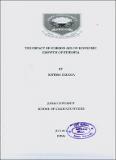| dc.description.abstract | Poor countries including Ethiopia need successful transformations that lead them to targeted
economic growth which in turn improves the living standard of their people. But under the
scenario of visible resource gap notably low domestic saving that does not satisfy the
increase in investment demand the targeted growth cannot be simply achieved. Thus, to fill
the resource gap the problem calls for the country to lookup for and depend on external
assistance from developed countries. However, there has been a great debate on the
contribution offoreign aidfor economic growth since the long years channeling of resources
to this country. Therefore, the main nidus of this study is to examine the impact offoreign aid
on economic growth of Ethiopia using multivariate co integration analysis over the period of
1969/70 to 2010/11.
The result of co integration test, using Johansen cointegration approach, indicates the
existence of long run relationship among the variables entered the specified growth model.
The estimated short run model comments that the current and past level of aid inflow entered
alone has a negative impact on economic growth. Similarly, current level of aid interacted
with policy has also negative effect on economic growth. However, in the long run foreign
aid inflow entered alone has a negative and significant impact on economic growth.
Whereas, aid interacted with policy appears to have a positive contribution to economic
growth of Ethiopia in the long run.
Thus, the results of the study calls for better focus on internal factors specifically investment
on human capital (labor force) and domestic investment arising from domestic saving to
foster economic growth than external one which can be uncertain even when donor countries
face long recession. In addition, the study also found that aid remains as a key tool of
enhancing the economic growth of Ethiopia if and only if assisted by favorable
macroeconomic environments (i.e., good monetary, fiscal and trade policies).
viii | en |


